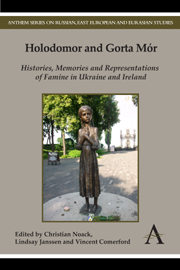Book contents
- Frontmatter
- Contents
- List of Figures
- Acknowledgements
- Introduction Holodomor and Gorta Mór: Histories, Memories and Representations of Famine in Ukraine and Ireland
- Part I Histories, Historiography and Politics
- Part II Public Commemoration
- Chapter 4 History and National Identity Construction: The Great Famine in Irish and Ukrainian History Textbooks
- Chapter 5 Teaching Hunger: The Great Irish Famine Curriculum in New York State Schools
- Chapter 6 Remembering Famine Orphans: The Transmission of Famine Memory between Ireland and Quebec
- Chapter 7 The Irish Famine and Commemorative Culture
- Part III Trauma and Victimisation
- Part IV New Sources and New Approaches to the Irish and Ukrainian Famines
- Index
Chapter 5 - Teaching Hunger: The Great Irish Famine Curriculum in New York State Schools
from Part II - Public Commemoration
Published online by Cambridge University Press: 05 May 2013
- Frontmatter
- Contents
- List of Figures
- Acknowledgements
- Introduction Holodomor and Gorta Mór: Histories, Memories and Representations of Famine in Ukraine and Ireland
- Part I Histories, Historiography and Politics
- Part II Public Commemoration
- Chapter 4 History and National Identity Construction: The Great Famine in Irish and Ukrainian History Textbooks
- Chapter 5 Teaching Hunger: The Great Irish Famine Curriculum in New York State Schools
- Chapter 6 Remembering Famine Orphans: The Transmission of Famine Memory between Ireland and Quebec
- Chapter 7 The Irish Famine and Commemorative Culture
- Part III Trauma and Victimisation
- Part IV New Sources and New Approaches to the Irish and Ukrainian Famines
- Index
Summary
The impetus for the Great Irish Famine Curriculum originated from initiatives that came from both sides of the narrow street in Albany, New York, that separates the chambers of the New York State Legislature from the headquarters of the New York State Education Department. In 1996, the State Education Department began to distribute copies of its new Learning Standards, the performance-based learning criteria designed to improve the quality of education in the State's public schools. A new set of assessments would be designed to ensure that all pupils in grades four, eight and eleven had reached the appropriate standards of competence in each of the middle and secondary school subjects. Because the assessments would be performance based, no curricula were provided for the new standards.
The following year, on the 150th anniversary of the worst year of the Great Irish Famine, Ann Garvey, president of the American Irish Teachers Association, approached Assemblyman Joseph Crowley, a member of the New York State Legislature, to urge that the a study of the Great Irish Famine be a required strand in the State Education Department's Human Rights Curriculum which, at that time, included the Atlantic Slave Trade and the European Holocaust. Crowley introduced the bill and steered it though the legislative process where it had enthusiastic bi-partisan support and was passed after a short debate.
- Type
- Chapter
- Information
- Holodomor and Gorta MórHistories, Memories and Representations of Famine in Ukraine and Ireland, pp. 103 - 114Publisher: Anthem PressPrint publication year: 2012
- 2
- Cited by

